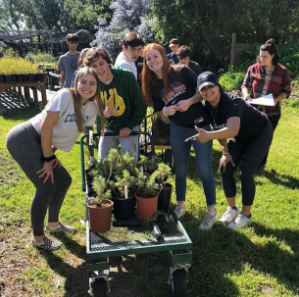How to Help the Environment in 4 Steps!

SHC Students taking action to save the environment! Credit: Mr. Le
Though you likely do not hold the power and ability to single-handedly stop global warming as a highschooler, every effort makes a difference and there are many easy, simple acts you can do to take action.

Credit: Bianca Guerrero ‘20
- Thrifting!
Thrifting is an easy and affordable way to help the environment as a highschooler. The fashion industry is a major contributor to waste and water pollution, especially fast fashion brands. Fast fashion encourages consumers to continually buy inexpensive or trendy clothes and then discard them after they are no longer deemed trendy. Not only does this use excessive amounts of water and generate waste to produce clothing so rapidly, but many of these inexpensive brands rely on child labor or unfair wages to support their business. Buying clothes from environmentally-friendly brands that use renewable or sustainable resources or purchasing your clothes from thrift stores can help reduce extreme water usage and pollution.

Credit: SHC Instagram
- Reduce Your Plastic Use!
A large percentage of our plastic inevitably ends up in our oceans, posing several detrimental risks towards marine life. Plastic is typically made of harmful chemicals that can take up to 1000 years to decompose and can pollute our air, water, and land. One way you can help reduce plastic pollution is by not purchasing pre-packaged goods. Though our school cafeteria’s packed goods such as the skittles, gummies, utensils, and plates are typically environmentally friendly, most of the larger name brands that produce items like granola bars, chips, ice cream, and especially the drinks are typically packaged with plastic, and not compostable or recyclable. Though one item may seem like a minor difference in terms of a much larger, more global issue, purchasing these items on a daily basis adds up. Try bringing a reusable water bottle, making your own food at home, or purchasing fewer items wrapped in plastic.

Credit: SHC Track and Field Team
- Sharing Rides!
Though these alternatives are unrealistic for many due to geographical logistics, gas emissions from cars release a lot of carbon, polluting our air and contributing to global warming. Some more environmentally friendly alternatives include carpooling with other students, taking the bus, or if you are really ambitious, biking or skateboarding.

Credit: Natalie Leong ‘20
- Eat Less Meat!
The meat production in itself is a major contributor to greenhouse gasses, pollution, deforestation, and more. Producing and manufacturing meat requires an immense amount of fossil fuels, pesticides, and water, ultimately releasing toxic chemicals into the air and destroying the earth. Though being vegetarian is not entirely challenging, if you don’t want to commit to that, simply reducing your intake of meat or even just red meat, can make a significant difference. Excessive meat intake also poses several health risks such as heart disease and high cholesterol. There are currently over a billion cows on the planet, each of which releases about 30 – 50 gallons of methane a day, a gas that is much more harmful to our environment than carbon dioxide.





